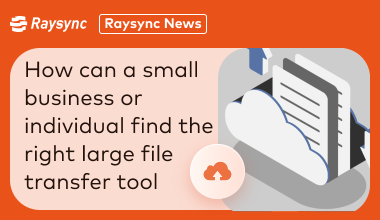How to solve the problem of sending UDP too fast?
In this data-driven era, the demand for high-speed and stable data transfer is constantly increasing. UDP (User Datagram Protocol), with its low latency and high efficiency, plays an important role in real-time communication and large data transmission. However, the connectionless and unreliability of UDP also brings a series of challenges, especially when the data transfer speed is too fast. This article will explore these problems in depth and introduce how Raysync protocol optimizes UDP transfer, enhancing the efficiency and stability of enterprise data transfer.
Part 1: Problems caused by too fast UDP transfer
Network congestion: When UDP packets are sent at a rate faster than the network's carrying capacity, it may lead to network congestion. This affects not just the transmission of UDP packets, but can also ripple to other network traffic, leading to an overall decline in network performance.
Data loss: Due to the absence of guarantee or complete UDP packets, the risk of packet loss significantly increases during high-speed transmission. This is a serious problem for applications requiring high reliability.
Application performance decline: Due to the unreliability of UDP, packet loss may trigger the retransmission mechanism at the application layer, increasing network load and causing the application performance to decline.
Part 2: Common Solutions
Traffic Control: By restricting the transmission rate of data packets, network congestion can be alleviated. However, traditional UDP traffic control mechanisms are relatively simple and cannot adapt to dynamically changing network environments.
Error Detection and Retransmission: Although UDP does not provide error detection and retransmission by itself, these features can be implemented at the application layer. Although this would add overhead, especially in high-speed transmission scenarios.
Quality of Service (QoS) Policy: By implementing QoS policies, priority processing can be provided for critical data packets. However, this generally requires support from network devices and may be difficult to implement in complex network environments.
Raysync Protocol: Raysync's UDP Optimization Solution
To deal with these issues more effectively, companies may choose more advanced solutions, such as using the high-efficiency file transfer software on the market - Raysync. Raysync uses its self-developed Raysync protocol, which is designed for large file transfer, can significantly increase transfer speed, achieving a transmission efficiency 100 times faster than traditional FTP/HTTP.
Rate Control and Congestion Control of Raysync Protocol: Raysync Protocol intelligently regulates the rate of data packet sending through its intelligent traffic control and congestion control algorithm, adapting to changing network conditions. This not only reduces network congestion but also improves the efficiency of data transfer.
Raysync Protocol Error Detection and Retransmission: Raysync protocol implements integrity checking and retransmission of lost data packets at the application layer, ensuring reliable data transfer. This mechanism reduces retransmission due to data loss and improves transmission efficiency.
Raysync Protocol's QoS Policy: Raysync protocol provides priority processing for key business data using priority queue, intelligent route selection, and dynamic load balancing QoS strategies. The combination of these strategies enables Raysync to provide stable and highly efficient data transmission services in complex network environments.
Conclusion
Raysync efficiently handles the challenges faced by UDP protocol in enterprise-level data transmission with a series of innovative optimizations. From traffic control to enhancing reliability, to the implementation of QoS strategies, Raysync demonstrates its powerful capability in improving data transmission efficiency and stability. Raysync is undoubtedly a solution worth considering for enterprises in pursuit of efficient and reliable data transmission.
You might also like

Raysync News
March 13, 2024How can a small business or individual find the right large file transfer tool?
With the file transfer needs of individuals and small businesses also changing, transferring and sharing large files efficiently and securely is an increasingly common challenge. Finding the right large file transfer tool is especially important.

Raysync News
February 2, 2024What to do during enterprise data migration with many small files and slow replication?
How to migrate and transfer a large number of small files efficiently. These small files on the server, although individually small in size, are often very slow to replicate during the migration process.

Raysync News
April 16, 2020A farewell to data jamming - healthcare industry welcomes full-speed data transfer
Raysync Transmission supports 10 Gigabit bandwidth and can easily meet the needs of the medical industry for high-speed data, secure transmission, and extremely fast transmission of massive files.